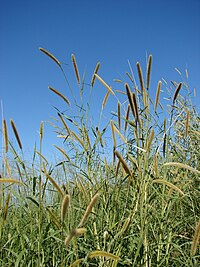
Photo from wikipedia
Abstract Elephant grass (Pennisetum purpureum) is an important fodder crop worldwide. Numerous plant pathogens have been found to infect this grass, which plays a major role as a reservoir for… Click to show full abstract
Abstract Elephant grass (Pennisetum purpureum) is an important fodder crop worldwide. Numerous plant pathogens have been found to infect this grass, which plays a major role as a reservoir for important pathogens of other grass crops including sugarcane. In this study, we collected 36 leaf samples and 108 juice samples from six symptomatic plants and 30 asymptomatic plants of elephant grass in Fuzhou, China for molecular detection of Xanthomonas albilineans, the putative causal agent of scald disease in grasses. X. albilineans was detected by PCR with specific primers XAF1/XAR1 in 25.0% (9/36) of the leaf and 5.6% (6/108) of the juice samples, while 55.6% (20/36) of the leaf and 81.5% (88/108) of the juice samples tested positive using a real-time quantitative PCR (qPCR) assay. PCR-amplified DNA fragments of two housekeeping genes, abc and gyrB, were cloned and sequenced from 15 positive samples, and the nucleotide sequences were 100% identical for both genes. Based on the concatenated sequences of the two genes (1512 nucleotides), phylogenetic analysis revealed that the X. albilineans strains infecting elephant grass clustered in the PFGE-B group with six reference strains from sugarcane that originated from Guadeloupe and Martinique (France), Florida (USA), and Fuzhou (China); All nucleotide sequences in this group were 100% identical. Additionally, two strains of X. albilineans isolated from elephant grass were identified as being highly pathogenic in young plants of elephant grass and sugarcane by artificial inoculation. The findings presented here attempt to address a gap in the literature, particularly with regard to molecular identification of X. albilineans naturally infecting elephant grass.
Journal Title: Crop Protection
Year Published: 2019
Link to full text (if available)
Share on Social Media: Sign Up to like & get
recommendations!